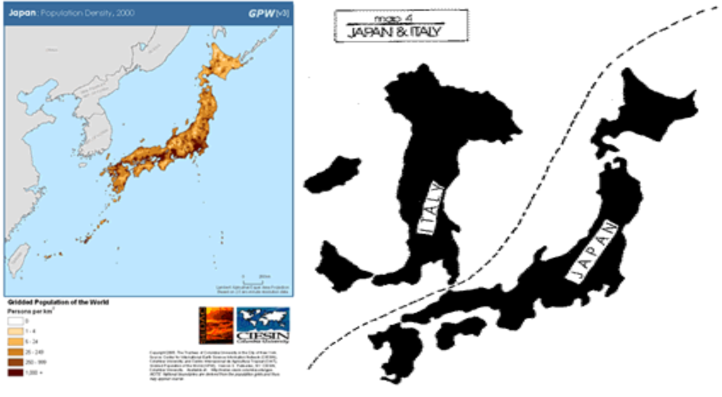VISUALIZING the People: Pictures of People in East Asia
Photos of Asia: China, Japan, Vietnam [terragalleria.com]
Each page of this website shows many color photographs of many places, urban and rural, of these countries. Put your mouse over a photograph for the caption; click on the photograph for an enlargement. This is a rich visual resource to explore. Hmong women in traditional dress at a market in northern Vietnam, the floating market in the Mekong delta region, a Shinto wedding procession in Tokyo, the Ginza district in Tokyo, Muslim storefront in Kunming, the Qingping market in Guangzhou, and views of Hong Kong from its harbor are just a few of the images that can be seen here.
A Visual Sourcebook of Chinese Civilization [University of Washington]: People
About China's population, its minorities, and languages, with photographs, maps, and quiz questions.
Population Size and Density
Some say that a country's population is its most fundamental geographic factor. Review the readings at the websites below while considering the degree to which this is true. Consider some of the following mappable characteristics of population distribution in China, Japan, Korea, or Vietnam:
Comparing Populations
Facts in Focus: Resource Guide for the World Population Data Sheet [Population Reference Bureau]
For grades 6-12. A series of short activities to provide access to the wealth of data on the world, regions and individual countries and to introduce students to major demographic concepts.Gridded Population of the World and the Global Rural-Urban Mapping Project NASA Socioeconomic Data and Applications Center (SEDAC)
The Asia "Continent Summary" section of this SEDAC website has a table listing countries and basic population statistics. Click on a country name (China, Japan, Korea, Vietnam) on the table for more detailed population data and a downloadable population density map (PDF) for that country.

Asia and East Asia
China
In terms of population China is, of course, the world's largest country, and China's population is its most significant resource. In 2020, China’s population was 1,439,323,776, or 1.4 billion people. Many Chinese provinces have populations that are the same size or larger than many major countries.
In addition to the sheer magnitude of China’s population, the PRC is interesting to study because Chinese policy makers have put a tremendous amount of effort in managing China’s population and trying to ensure steady economic growth for the nation and its citizens. As we shall see in the following explainer, many of the policy steps China has made has had noticeable impacts on population growth, demographics and economic development.
China's Population [Asia for Educators], by Andrew Wortham, which is quoted below, examines the issue of population as a resource in China and covers the following topics. Clicking on a link will bring up the unit in another window.
Questions for Discussion that can be used to guide students through the material are grouped together at the end of the unit. Click here.
China's Population Growth: Growing, Growing, Graphing! [ThirteenEd Online]
For grades 7-12. This lesson plan combines geography and mathematics. Resources include websites with current and archived population data, government websites, and mathematical websites with interactive graphs comparing linear and exponential functions.-
Global Urban Explosion — Shanghai [China Institute]
-
China's Population: New Trends and Challenges (PDF) [Population Reference Bureau]
This lesson plan can be used as another resource. Population Reference Bureau Date Sheet and Teachers Guide
Population distribution over the land affects "density: the coloration of China's population density map, in this example, shows that there are areas, as in the north, where the population is 1000 or more per square kilometer, and other areas, as in the west, where it is under 1 per square kilometer.
 Population Density Map of China 2000 [SEDAC]
Population Density Map of China 2000 [SEDAC]Japan
Japan's population is large for its land area. As of 2020, it was the 11th most populous country in the world.
Japan's population is also remarkably homogeneous from an ethnic and linguistic perspective.
A striking feature of Japan's population is that it is rapidly aging, as the country has the world's highest life expectancy coupled with declining fertility rates (actually below replacement).
Although the rate of growth has slowed significantly in recent decades, Japan's population actually began to decline in 2006.
Unlike countries in Europe and America, migration into Japan is quite low.
In comparison to the land area of the United States, the Japanese islands account for a relatively small land area (about the size of Montana or California), but in comparison to the many nations of Europe, Japan is about average.
Japan's relatively small land area coupled with its large population results in high population density.
Also, Japan's land area is not only small, but very mountainous. Mountains cover four-fifths of the land. Cities and farms compete for the small amount of land that is flat.
What can you say about the relative sizes of the United States and Japan?
How does Japan's population density compare with other nations?
Where Have All the Children Gone? The Consequences of Low Fertility Rates in South Korea, Singapore, and Japan [Asia Program, U of Tennessee, Chattanooga]
The Korean Peninsula
In 2020, South Korea a population of 51 million (#28 in world rank) and North Korea had a population of 26 million (#54 in world rank).If combined, the population of the Korean peninsula would be 77 million (c. #20 in world rank), making it the 4th largest of the East Asian countries and larger than that of either the United Kingdom or France, if compared with European countries.
Population Density Map of Asia showing North and South Korea
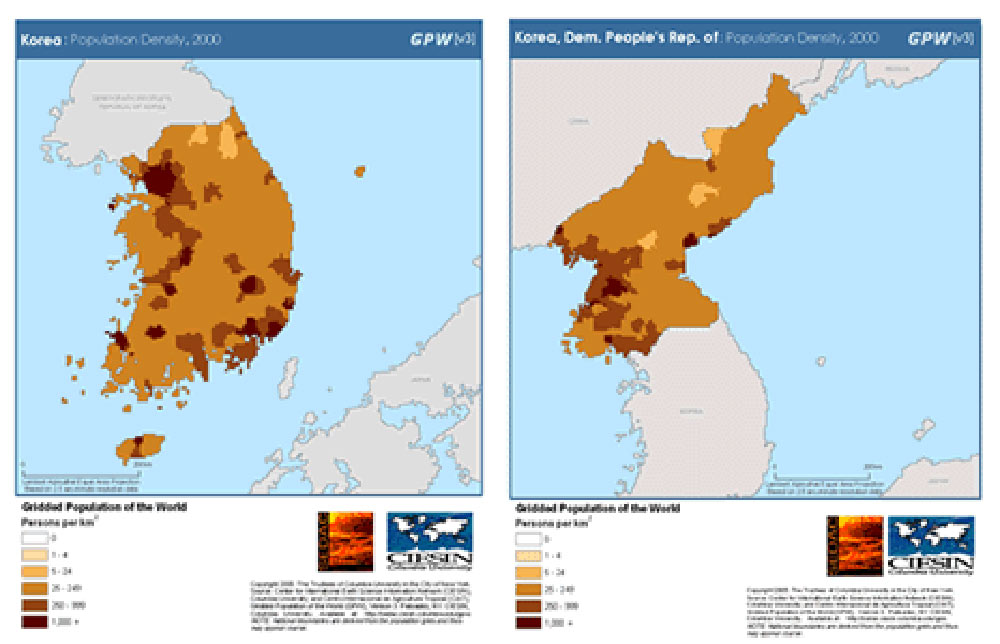
Population Change and Development in Korea [Asia Society]
Korean society has undergone a major transformation since 1960. An economic miracle, demographic transition, urbanization, changes in family life, and the formation of civil society constitute the major features of the transformation.Understanding Korea's Changing Demographics [Korea Society]
Where Have All the Children Gone? The Consequences of Low Fertility Rates in South Korea, Singapore, and Japan [Asia Program, U of Tennessee, Chattanooga]
Vietnam
Although rarely thought of as a country with a large population, Vietnam, has a population of more than 97 million.
In 2020, it was the 15th most populous country in the world. Its population is slightly smaller than that of Germany, Europe's most populous country and number 19 on the list, and
Vietnam's population exceeds the population of France or the United Kingdom, both of which have populations of about 60 million.


Brief Description and Facts about Vietnam [WorldAtlas.com]
Number of Active NGOs by Population Density, Vietnam 1999
This map shows Vietnam's population density distribution while also indicating where Non-Governmental Organizations (NGOs) are active in the country.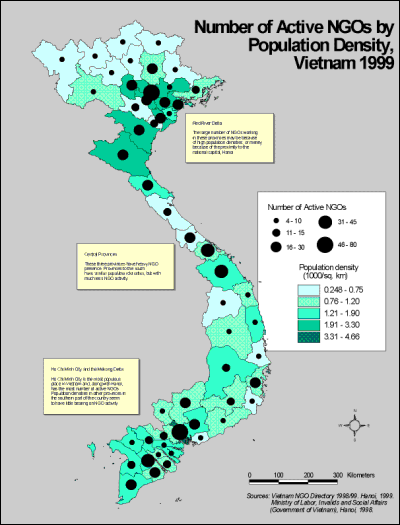
Minorities in Populations
All four countries of East Asia have minority populations. Have students undertake research on the minorities in each country.
China
A Lesson Plan on Chinese Minorities [U of Texas]
Map of China's Ethnolinguistic Groups.Ethnic Minority Groups in China [SPICE, Stanford University]
Although approximately 92 percent of China's population is classified as ethnically "Han," the remaining 8% comprise some 55 other ethnic groups (also called "minority nationalities"). This multi-faceted series of lesson plans (available at the SPICE website for purchase) looks especially at the Hui, Tibetans, Mongols, and Miao minority nationalities.The People of China [A Visual Sourcebook of Chinese Civilization, University of Washington]
A discussion of China's multiethnic cultures, with maps and photos.China's Ethnolinguistic Groups [Perry-Castañeda Library Map Collection, University of Texas]
Japan
Social Fabric of Japan: Case Studies of Selected Minority Groups [SPICE/Stanford]
Even though Japan is not as diverse as the United States or any European country, there are minorities in Japan.
Korea
Korea: Diverse Korean Communities [Korea Society]
Vietnam
Vietnamese Ethnic People [Vietnam Museum of Ethnology]
Culture Mosaic of East Asia
The four countries that make up what we call "East Asia" — China, Japan, North and South Korea, Vietnam — all have elements of commonality, but, of course, there is also great diversity amongst them.
Languages
The four countries of East Asia:
Have different spoken languages:
China Sino-Tibetan family of languages
Korea and Japan Eurasiatic or Altaic family of languages
Vietnam Austroasiatic family of languages
Written language, on the other hand, was decisive. East Asia exists, despite enormous internal linguistic diversity, in large part because of the universal application throughout the region—and only this region—of the Chinese writing system.
For all the spoken languages that exist in the world, there are actually very few writing systems. Most peoples in history adopted the writing system that they found developed closest to them, geographically. In East Asia, the Chinese developed the first written script c. 1200 BCE. Korea, Japan, and Vietnam:Used the Chinese writing system to write their own spoken languages
Over time, they adapted, modified, and added the this writing system to better fit the sounds and syntax of their own spoken language
At the same time, the ambassadors, bureaucrats, diplomats, scholars and religious thinkers all learned and used classical Chinese – written and spoken – to communicate with one another, from roughly the 7th through the 19th century. This was similar to the use of Latin in Western Europe in the classical period and later of French, when France came to dominate in size and to send out ambassadors around the 1700s. The elites of all four countries exchanged ideas on Confucianism and Buddhism, and they did this in classical, written Chinese. Thereby creating a shared “East Asia civilization” just as Latin and French had facilitated the evolution of what is referred to as “Western civilization.”
Classical Chinese remained the most prestigious written language throughout the East Asian region until as late as the nineteenth century—the visible insignia of a common literate standard of civilization. [Genesis of EA, p. 8]
Chinese
Chinese language inscriptions, and therefore Chinese history in the truest sense, first appear on the Central Plain around 1200 B.C. This was a development whose significance cannot be overstated. [Genesis of EA, p. 8]
The continuous use for over 3,000 years of this same language and this same script (with some modifications) lies at the very heart of the Chinese cultural tradition, and literature written in the classical Chinese language also forms the most critical link binding China to the other, non-Chinese, parts of East Asia, very visibly demarcating them from the rest of the world. [Genesis of EA, p. 8]
The East Asian (Chinese-based) scripts have been called the only writing systems on earth still in normal use today that did not derive ultimately from Egyptian. [Genesis of EA, p. 8]
Note on Chinese Characters throughout China and East Asia
The meaning of Chinese characters, used as a writing system, can be understood by people who speak different dialects and languages throughout China and in the other East Asian countries of Japan, Korea, and Vietnam. The easiest way to think how this is possible is by analogy to the use of Arabic numerals, “1,” “2,” etc, which have the same meaning wherever they are written, despite the pronunciation of the numeral in the language of the writer.
The Chinese Language [Asia for Educators]
This overview of the Chinese language, both spoken and written, includes an introductory reading for teachers; a pronunciation guide to Mandarin Chinese; and a reading about the history, pronunciation, and writing system of the Chinese language.Chinese Language: Myths and Facts [Asia Society]
Short, informative essay debunking popular notions that Chinese "write in pictures" or that Chinese is a monosyllabic language, where every word is a single syllable. An informative introduction to the language and its place in China and the larger East Asian civilization.Chinese Writing [Asia Society]
Brief essay explaining the nature of Chinese characters as a writing system.Learning Chinese Online [California State University, Long Beach]
An excellent resource for all aspects of learning the Chinese language. Developed by Dr. Tianwei Xie of the Department of Asian and Asian American Studies at California State University, Long Beach. Select "Characters" from the side menu, then "Animated Characters" from the list on the main page for animated demonstrations of the order of strokes for many of the most common Chinese characters.Chinese Calligraphy [Asia for Educators]
This introduction to Chinese calligraphy includes a reading on Chinese calligraphy, discussing its various styles, techniques, and materials; two calligraphy exercises for the classroom; and discussion questions.Calligraphy [A Visual Sourcebook of Chinese Civilization, University of Washington]
A Visual Sourcebook of Chinese Civilization, prepared by University of Washington history professor Patricia Buckley Ebrey, is an excellent resource, with images, questions for discussion, s, maps, and suggested readings throughout. This particular unit discusses types of Chinese calligraphic script; techniques of transmission; and calligraphy during three periods of Chinese history -- the Six Dynasties period, the Tang period, and modern China.Chinese Calligraphy [Asia Society]
"Chinese calligraphy has a two-millennia long history. [This background essay explores] the beginnings of, ideas behind, reasons for, and technologies that gave rise to this compelling art form."Chinese Calligraphy, the Art of Writing [China Institute: China360]
Scholars generally recognize that there was four times in the world that writing was invented. Egyptian and Maya hieroglyphs, Chinese characters and Sumerian cuneiform, which is what our alphabet derives from. All but the Chinese written language is phonetic... The Chinese have been writing for over 3,500 years.Chinese Names [Asia for Educators]
An overview of the Chinese practice of generational naming with meaningful characters.What's in a Name? Chinese Rivers, Cities, and Provinces [Asia for Educators]
A translation exercise with the names of Chinese rivers, cities, and provinces.Traces of Ideas: Communicating through Writing and Technology [Visible Traces, Asia Society]
The "Traces of Ideas" section of the Visible Traces curriculum (based on the 2000 exhibit Visible Traces: Rare Books and Special Collections from the National Library of China) includes two essays relevant to Chinese calligraphy: "Tradition and Transformation in the Chinese Writing System," which examines the characteristics of written Chinese and its development over time, and "Writing and Technology in China," which examines technologies for writing and printing.Chinese Script and Language [Omniglot]
A concise discussion of the origins and history of Chinese written language. With diagrams.
Japanese
SPEAKING AND WRITING [Asia for Educators]
About speaking and writing Japanese, with a discussion of "kanji" — Chinese characters adapted for written Japanese.Japanese (Nihongo) [Omniglot]
A concise discussion of the origins and history of Japanese written language. With diagrams. Also see Japanese Kanji on this website for explanatory text and charts about the use of Chinese characters in written Japanese.
Korean
The Korean Language [Asia Society]
Overview of the Korean language.The World's Most Incredible Alphabet [Asia Society]
An explanation of the origins and features of the Korean alphabet, han'gul. Includes video interview of linguist James McCawley and visual resource of the script.Korean [Omniglot]
A concise history of written Korean. With charts of the Hangeul (Han'gul) alphabet.An Introduction to Korean: Chart of Korean Letters, with Pronunciation Guide [langintro.com]
Shows Korean consonants and vowels in separate charts, with romanized sounds provided.The Korean Alphabet [Korea Society]
Vietnamese
Vietnamese [Omniglot]
The Origin and Nature of the Vietnamese Language [San Jose State University]
Vietnamese [U of Pennsylvania]
Food
There are many foods that are common to East Asian countries. Two of the more prevalent ones are tea and rice.
Tea
"Historically, tea‘s origins date back to around 2700 BC. It is thought to have first been discovered in the mountainous areas of China‘s far western Sichuan and Yunnan provinces." [Source: China.com]
Tea culture spread throughout East Asia and eventually to the West. Many traditions in China, Korea, and Japan involve tea drinking.
The maps below show tea growing areas in East Asia and China, respectively. Formosa, shown on these maps, is present-day Taiwan, but the name Formosa continues to be used in names of teas, the most commonly known one being "Formosa oolong." (Oolong is a kind of tea made by picking and drying clusters of three tea leaves and one bud, which are then processed in a particular way to provide a delicately flavored tea. For more on the oolong process, go to The Oolong Tea website.)
Plant Profile: Tea [Plant Cultures] A short profile of the tea plant, with images.
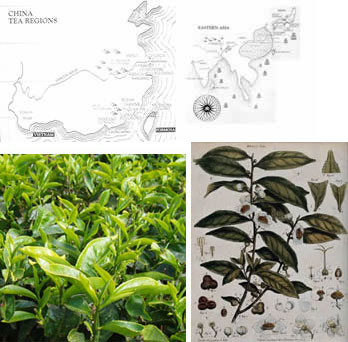 Engraving of a tea plant with flowering stem and floral segments. Source: Wellcome Library, London.
Engraving of a tea plant with flowering stem and floral segments. Source: Wellcome Library, London.Tea in China
The Edible Journey Through China [ThinkQuest]
Click on "Teahouse" on the bottom of the page for two sections focused on tea. "History Corner" — for a short history of tea in China — and "The Tea Laboratory" — for an overview of different types of tea and tea customs.
Tea in Japan
Cornell University Teahouse Project [Cornell University]
An excellent website for learning about Japanese traditions in architecture, ceramics, and tea drinking. Video clips, photographs, and text illustrate the construction of a traditional Japanese tea house, starting from the seeding of rushes all the way to the finished structure.The Japanese Tea Ceremony (Chaji) [Holy Mountain Trading Company]
A description of the tea ceremony, the implements used, the tea house, the spiritual aspects. With photographs.Japanese Tea Ceremony
Complete descriptions of all aspects of the tea ceremony and links to other sites with information on this subject.
Tea in Korea
Korea: The Other Tea Country [TeaMuse Newsletter]
An article about the history of tea drinking in Korea.The Korean Way of Tea [Korea Society]
Rice
Rice in East Asia
Wet Rice Agriculture in China [Asia for Educators]
Throughout East Asia, rice is a common agricultural crop, food, and trading commodity. The following short reading introduces the wet rice agricultural system. The link will open a new windowInternational Year of Rice: 2004 [United Nations Food and Agricultural Organization (FAO)]
List of Websites Prepared for the 2004 International Year of RiceRice Knowledge Bank [International Rice Research Institute]
Online multi-media resources about rice in East and Southeast Asian countries
Rice in China
China's Food and Geography [Asia for Educators]
A classroom exercise with teacher note, essay, and questions for discussion about different Chinese food regions.Ordering a Chinese Meal [Asia for Educators]
This exercise is designed to introduce students to Chinese cuisine.
Rice in Japan
RICE: It's More Than Just a Food [PDF] [Japan Digest, November 1993]
Rice as a cultural concept in Japan.Japan's Secret Garden: Miracle of Rice [NOVA, PBS]
A good presentation of rice culture in Japan. With text, photos, links.Japan Teaching Module: Geography Component 2: Centripetal Forces in Japan: Rice Cultivation [University of Tennessee at Chattanooga]
Rice in Korea
Korean Food: Rice and Rice Dishes [Life in Korea]
Information about rice in Korea and recipes are included.A Korean Meal: Teaching Confucian Manners Through Dining Etiquette [Korea Society]
Korean Food [PBS]
Rice in Vietnam
-
Voyage to Vietnam – Rice [Children’s Discovery Museum of San Jose]
Rice has been grown in Vietnam for thousands of years. It is one of the top five largest rice producing countries in the world. The Mekong River Delta (the 'Rice Bowl') in southern Vietnam is where most of Vietnam’s rice is grown. Rice is also grown in the Red River Delta in the northeast part of the country, and on the north-central coast. Most rice grown in Vietnam is wet-rice, meaning that it is grown in flooded fields rather than dry land. Rice Expert
This large website was constructed by students in Taiwan. It contains information and photos about every aspect of the rice industry in the Huatung Valley in Taiwan. First click on to the heading links on the side of the page and then on to white links on the black background to find all the information.Photograph: Rice in Vietnam (Ho Chi Minh City) [terragalleria.com]
This photograph shows how different types of rice are s[old in Vietnam.Voyage to Vietnam – other foods of Vietnam [Children’s Discovery Museum, San Jose]
Chopsticks
Brief History of Chopsticks [History Channel]
The History of Chopsticks [Smithsonian]
Surprising Facts about the History of Chopsticks [Cambridge University Press]
Clothing
People in East Asia today wear “international clothing,” just as people in the United States and all over the world wear. The images shown here are those of “heritage clothing” what would have been worn traditionally and is often still worn on important dates and for celebrations in these countries. (People in the United States, when asked to wear “traditional clothing,” would be more inclined to wear “heritage clothing” from the country of their ancestors or choose clothing worn in the early days by settlers throughout the United States.)
China
-
Imperial Robes [Metropolitan Museum of Art]
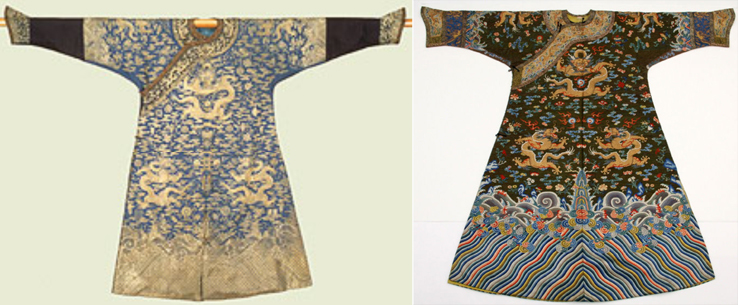
Carpenter, 1899 (left) and ""Sing-song Girl"", late 19th C. [Visual Sourcebook of Chinese Civilization, University of Washington]

Yi Woman in traditional costume, Sichuan province, 1980s [Visual Sourcebook of Chinese Civilization, University of Washington] (left), Chinese monk wearing robes in the Mahayana tradition, 20th C (right) [Buddha Dharma Education Association]

Woman's Ceremonial Robe (the Bat Medallion Robe) China, 1700s China, 1700s [Metropolitan Museum]

Japan
-
Noh Robe, Edo period (1615-1868), second half of the 18th C [Metropolitan Museum of Art]

Embroidered coat (attush), Ainu, Kokkaido, late 19th C
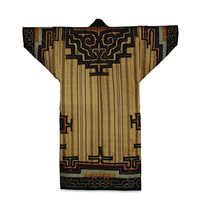
Commoner in Kosode (short-sleeved kimono), early Edo period


Buddhist monk of Jishu sect in ami-e robe, Kamakura period
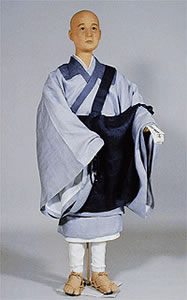
Samurai in chain undergarment and helmet, Edo period
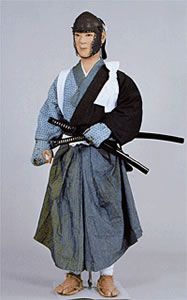
Korea
Handbok for women, 20th C. based on Joseon dynasty (1392-1910) styles

Handbok for man, 20th C. based on Joseon dynasty styles
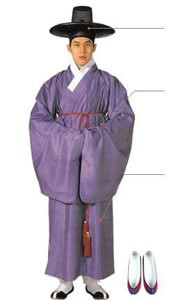
Ceremonial robes for the king and queen, Joseon dynasty

Korean monk wearing robes in the Mahayana tradition, 20th C
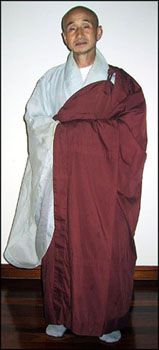
Vietnam
Voyage to Vietnam: Attire [Children’s Discovery Museum of San Jose]
(text and photos courtesy of this website)The national traditional dress in Vietnam is the ao dai, a silk tunic with pants worn by women and men. Ao dài are worn for special occasions including Tet, the new year celebration. Since the twentieth century, Vietnamese people have also worn contemporary clothing that is popular in many places in the world.

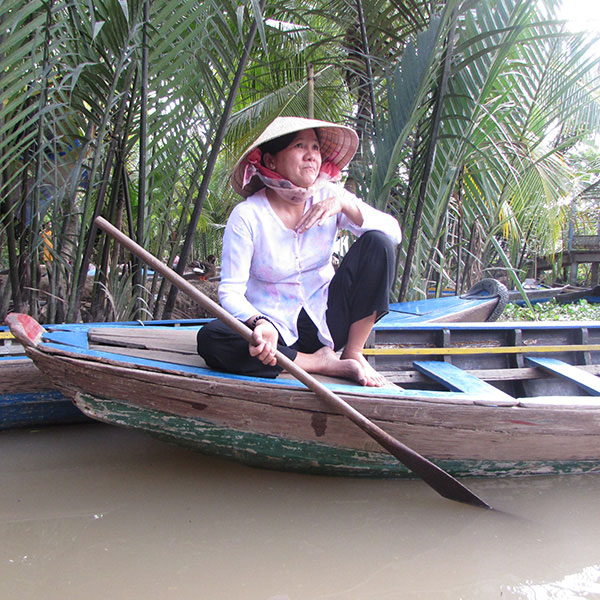
Religion
The Nature of the Cosmos
China
-
Living in the Chinese Cosmos – The Chinese Cosmos: Basic Concepts [Asia for Educators]
Korea
Taegeuk: The South Korean Flag [Asia Society] RELIGION
The elements of the flag symbolize the dual forces of nature. The red and blue circle in the middle of the flag is called taegeuk in Korean (t'ai chi in Chinese), which, translated literally, means "supreme ultimate." The circle is divided into two parts, each of which resembles a comma. The upper, red part represents the forces of yang (yang in Chinese as well), and the lower, blue part represents the forces of um (yin in Chinese).
ANCESTOR Veneration and Popular Religion
China
-
Living in the Chinese Cosmos – Popular Religion [Asia for Educators]
Vietnam
Voyage to Vietnam – Altars [Children’s Discovery Museum of San Jose]
Nearly every home, office, and business in Vietnam has a small altar to honor ancestors. The altar usually includes an incense burner, at least one vase for flowers, a small oil lamp, and a place to make offerings of food, sweet treats and tea. Hanging next to the altar or sitting on the altar are photos of family members who have passed away.Religion in Vietnam [Asia Society]
An introductory essay on Vietnamese world view throughout the ages.Worshiping the Ancestors [Cornell University, Center for Inter’l Studies]
Family Altars in Vietnam and Rice in Vietnam [Cornell University]
Students will identify the major religions practiced in Vietnam, and the basic tenets of each religion. Understand that Vietnamese (as indeed most Southeast Asians) rarely believe that these religions are mutually exclusive. Identify the main components of a family altar, and the use or symbolism of each item. Explore the impact of the Cult of Ancestors on family life in Vietnam.
Korea
Historical and Modern Religions of Korea [Asia Society]
Unlike some cultures where a single religion is dominant, Korean culture includes a wide variety of religious elements that have shaped the people's way of thinking and behavior. In the early stages of history in Korea, religious and political functions were combined but later became distinct.Korean Belief Systems [Asia Society]
Excerpts from Jesus' Sermon on the Mount; Buddhism's Four Noble Truths; Confucius' Analects to be used to examine the confluence and co-existence of belief systems in Korea.Religion in Korea [PBS]
Japan
Ancestor Worship in Japan
Most of the historically known practices of ancestor worship in Japan are adaptations of Chinese customs. With the passage of time and in coexistence with the Shinto religion, Japanese Buddhism began to emphasize death rites and commemorative ceremonies. Although Confucianism was never fully developed in Japan, quasi-religious Confucian ideals of filial piety became important and were sometimes incorporated in the teachings of Japanese Buddhist sects, thereby reinforcing respect for ancestors (Tamaru 1972)
BUDDHISM
Buddhism in East and Southeast Asia
Buddhism [OMuERAA, Asia for Educators]
Spread of Buddhism on the Silk Road
 Map showing the northern and southern paths of the Overland Silk road linking China and the West and the location of Dunhuang [The British Museum]
Map showing the northern and southern paths of the Overland Silk road linking China and the West and the location of Dunhuang [The British Museum]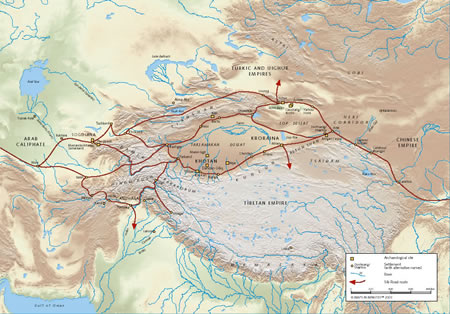 Map of the Eastern Silk Road [PDF] [The British Library]
Map of the Eastern Silk Road [PDF] [The British Library]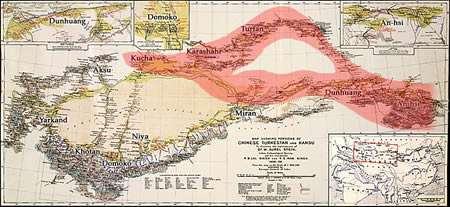 Map showing where Chinese Buddhism florished along the Silk Road [The British Library]
Map showing where Chinese Buddhism florished along the Silk Road [The British Library]Visions of Enlightenment: The Art of Buddhism [Pacific Asia Museum] Online exhibit with teaching materials, including map of the Spread of Buddhism.
Buddhism on the Silk Road [International Dunhuang Project]
The International Dunhuang Project is "a ground-breaking international collaboration to make information and images of all manuscripts, paintings, textiles and artefacts from Dunhuang and archaeological sites of the Eastern Silk Road freely available on the Internet and to encourage their use through educational and research programs." This website is a truly comprehensive resource for teaching about the Silk Road. See especially the EDUCATION>TEACH section for teaching websites on various topics, including Buddhism on the Silk Road. "The civilizations which flourished along the Silk Road in the first millennium CE were open to cultural and religious influences from both East and West. Many religions, including Christianity, Buddhism, Hinduism, Islam, Zoroastrianism and Manichaeism, gained new followers. But it was Buddhism, travelling the trade routes of the Silk Road, which became the common factor uniting the different peoples of the Silk Road.”Buddhism and Its Spread along the Silk Road [Silk Road Foundation]
Text with images, area maps, timeline of events, and names of key figures in the spread of Buddhism from India to East Asia.Religions along the Silk Roads: Central Ideas of Buddhism [PDF] [China Institute]]
Unit N from From Silk to Oil, a comprehensive view of the Silk Roads over four thousand years. "This unit consists of three lessons. Students will (1) read about the life of the Buddha and reflect on some very different ways of defining success; (2) learn about the Bodhisattva ideal and the Bodhisattva Guanyin, the Buddhist 'Goddess of Mercy'; and (3), look at the Buddhist view of morality."Lesson 1: The Story of the Buddha and the Four Noble Truths
Essential Question: How might the story of the Buddha’s life make us reconsider our understanding of success?
Hand Out: The Story of the BuddhaLesson 2: Mahayana Buddhism and the Bodhisattva Guanyin
Document 1: A Passage From The Lotus Sutra
Document 2: A Guantin Miracle Story
Essential Question: Who is Guanyin and what does she tell us about how people find solutions to the problems of life?
Lesson 3: Buddhist Moral Teachings
Essential Question: How do Buddhists define right and wrong, good and evil, and moral behavior? For Buddhists, what is a moral life?
Hand Out: Basic Buddhism and Buddhist Morality
Activity: Buddhist Morality—Student Questionnaire
Belief Systems along the Silk Roads [Asia Society]
"Religious beliefs of the peoples of the Silk Road changed radically over time and was largely due to the effects of travel and trade on the Silk Road itself. For over two thousand years the Silk Road was a network of roads for the travel and dissemination of religious beliefs across Eurasia."
Excerpts from Religious Texts [Background Essay]
"The Silk Roads encompassed a diversity of cultures embracing numerous religions and world views from a vast region stretching from Venice, Italy, to Heian (present day Kyoto), Japan. Between these two geographic endpoints, belief systems that are represented include Buddhism, Confucianism, Christianity, Daoism, Hinduism, Islam, Judaism, and Shinto. ... This reading features thematic comparisons among texts of [these] great world religions.The Golden Rule of Reciprocity [Lesson Plan]
Uses excerpts of translated religious texts (link above). "Students learn about Golden Rule of Reciprocity by comparing quotes from the major world religions. Students then create their own rendition of the Golden Rule."
Buddhism in China
Buddhism [A Visual Sourcebook of Chinese Civilization, University of Washington]
"This unit offers evidence of how Buddhism changed China's visual culture, showing the evolution of images of deities, plus views of temples and people practicing Buddhism." A Visual Sourcebook of Chinese Civilization was prepared by University of Washington history professor Patricia Buckley Ebrey. With questions for discussion, timelines, maps, and suggested readings. Select HOME to find link to teachers' guides for all topics featured on the website.Buddhism: The "Imported" Tradition [Asia for Educators]
This section of the AFE teaching module, Living in the Chinese Cosmos: Understanding Religion in Late-Imperial China, 1644-1911, examines the history of Buddhism in China. Includes a general overview of Buddhism and its origins in India.Buddhism in China [Asia Society]
"A short introduction to Buddhism in China. In understanding Chinese belief systems, it is important not to take terms at face value; the word "religion" (zongjiao), for example, did not exist in the Chinese lexicon until the 19th century. Appreciating the complexity of Chinese belief systems is crucial to understanding the forces that helped shape China.
Buddhism in Japan
Buddhism in Japan [Asia Society]
An Introduction to Japanese Buddhism [Asian Art Museum of San Francisco]
Video presentation: Professor Robert Sharf, University of California, Berkeley, discusses Japanese Buddhism at the Medieval Japan Teacher Institute at the Asian Art Museum.
Buddhism in Korea
Long Distance Trade and its Impact on the Spread of Buddhism in Korea [Korea Society]
The Belief Systems of Ancient Korea: A Case Study of Cultural Diffusion inthe Far East [Korea Society]
CONFUCIANISM
The Three Teachings [Asia Society]
There is an enduring significance of Confucianism in East Asian culture, and its intersections with Daoism and Buddhism, collectively known as the "three teachings" of Chinese traditionConfucianism in Korea: Ancient and Contemporary [Korea Society]
Introduction to Confucian Thought [Asia for Educators]
A background reading about the impact of Confucian philosophy on Chinese government and society.What Did Confucius Say? [Asia for Educators]
A short background reading about Confucius the person and his writings.Teaching/Learning through Confucius: Navigating Our Way through the Analects [PDF] [Education About Asia, Asociation for Asian Studies]
Lesson Plan • Confucianism: Understanding and Applying the Analects of Confucius [PDF] [Education About Asia, Association for Asian Studies]
A lesson plan asking students not only to explain the meaning of a passage from the Analects but also to give a contemporary example of the situation Confucius describes.Video Unit • The Confucian Tradition [Asia for Educators]
A video unit on Confucius and the influence of his teachings. Featuring Irene Bloom and Wm. Theodore de Bary from Columbia University - and Asia Society President Emeritus, Robert Oxnam. Section Topics:
Video Unit • Confucian Teaching [Asia for Educators]
A video unit on Confucian teachings covering the three essential values on which Conficianism rests: filial piety, humaneness, and ritual. Featuring Irene Bloom, Wm. Theodore de Bary, and Myron Cohen from Columbia University - and Asia Society President Emeritus, Robert Oxnam.
Section Topics:
1. Three Confucian Values
• Filial Piety (Xiao)
• • • Ancestor Worship
• • • Humaneness (Ren)
• • • Ritual (Li)
• • • • • Ritual in Everyday Life
2. Reciprocity/The Five Relationships
• Man Is a Social Being
3. On Government
• The Gentleman
4. On Education
• The Classics
5. Is Confucian Thought Religious?
• The Emperor and the Mandate of Heaven
Confucius/Kong Fuzi/Kong Qiu, 551-479 BCE
Primary Source w/DBQs • Selections from the Confucian Analects [PDF] [Asia for Educators]
Primary Source w/DBQs • Selections from the Confucian Analects: On Humaneness [PDF] [Asia for Educators]
Primary Source w/DBQs • Selections from the Confucian Analects: On Confucius as Teacher and Person [PDF] [Asia for Educators]
Mencius/Mengzi/Meng Ke, 4th Century BCE
Primary Source w/DBQs • Selections from the Mencius: On Human Nature [PDF] [Asia for Educators]
Xunzi/Xun Qing/Xun Kang, ca. 310-ca. 219 BC
Primary Source w/DBQs • Selections from the Xunzi: "Human Nature Is Evil" [PDF] [Asia for Educators]
Primary Source w/DBQs • Selections from the Xunzi: "Encouraging Learning" [PDF] [Asia for Educators]
Primary Source w/DBQs • Selections from the Xunzi: "A Discussion of Rites" [PDF] [Asia for Educators]
DAOISM
Introduction to Daoism [Asia for Educators]
A brief introductory overview of Daoism and the writings of Laozi and Zhuangzi.Lesson Plans • Taoism and the Arts of China [The Art Institute of Chicago]
An excellent website for teaching about Taoism. Covers the following three themes: 1) Taoist Tradition (discusses Laozi, Taoist cosmology, and the sacred immortals); 2) Taoist Church (discusses religious Taoism, ritual, and the Taoist pantheon); 3) Taoist Renaissance (discusses popular religion, divine manifestations of yin, and inner alchemy). Also features more than 25 works of art, related diagrams, a map, , glossary, bibliography, and six lesson plans for the middle- and secondary-school levels.Daoism [Asia Society]
An introductory overview.Lesson Plan • Attitudes Towards Nature in Daoist Art [Asia Society]
A short lesson that "helps students understand the difference between how many Westerners view nature versus how many Chinese (particularly Daoists and the literati) felt about the natural world around them. [Uses] Chinese poems and landscape paintings as primary sources."Laozi, ca. 3rd Century BCE
Primary Source w/DBQs • Selections from the Laozi (Daodejing) [PDF] [Asia for Educators]
Zhuangzi/Zhuang Zhou, ca. 360-280 BCE
Primary Source w/DBQs • Selections from the Zhuangzi: Chapter 3, "The Secret of Caring for Life" [PDF] [Asia for Educators]Laozi, ca. 3rd Century BCE
Primary Source w/DBQs • Selections from the Laozi (Daodejing) [PDF] [Asia for Educators]
Zhuangzi/Zhuang Zhou, ca. 360-280 BCE
SHINTO
Shintô [Asia for Educators]
Text adapted from an article originally published in 1982 in FOCUS magazine, by Paul B. Watt, currently professor of Asian studies at DePauw University. Includes discussion questions for students.Religion & Ethics: Shinto [BBC]
The BBC's Religion & Ethics portal page on Shinto, with links to articles about many aspects of Shinto, including beliefs, history, rites and rituals, key texts, and festivals.Sacred Spaces in Shinto [Teaching Comparative Religion through Art and Architecture, Office of Resources for International Area Studies, University of California at Berkeley]
Excellent information about Shinto shrines. This is a visual resources website created for a teacher workshop on teaching comparative religion through art and architecture.-
Japan Teaching Module: Geography Component 2: Centripetal Forces in Japan: The Shinto Religion [PDF] [University of Tennessee at Chattanooga]
Shinto: Japanese Religion [Asia Society]
Shinto (literally “the way of the gods”) is Japan's native belief system and predates historical records
SHAMANISM
Old Gods, New Times: A Shaman Ritual in South Korea [Education about Asia]
Shamans are religious specialists who are perceived as having the capacity to deal directly with spirits on behalf of the community, either by sending their own soul on a journey to other realms or by calling them into the here and now and manifesting them in their own bodies. Shamans bear witness to their encounters with spirits through their own bodies, either ina journey undertaken in a trance state or by manifesting the spirits’ presence through their ownvoice, gestures, dances, and mimes. Because shamans were first described in Siberia among hunters and herders, their work is sometimes described as an “ancient” or “primitive” religion, but shamans have had long and expansive histories in the sophisticated kingdoms and then nation states of East and Southeast Asia. As the following account illustrates, a living shamanic practice must effectively engage the contemporary world around it.Korean Shamanism Today [Korea Society]
Korean Shamanism - A Case Study in Modern Day Animism [Korea Society]
Religious Plurality - Korea A Case Study [Korea Society]
Houses Architecture and Geomancy
ARCHITECTURE
China
A Visual Sourcebook of Chinese Civilization [University of Washington] House Architecture: Regional Variation
Photographs, text, and questions for studentsTeaching about Chinese Houses: My Home, Your Home [Ronald G. Knapp, SUNY New Paltz]
This website includes links for handouts, an extensive list of websites, and a bibliography. It is a vast research resource for teachers and students. The website serves to guide teachers and students:
To encourage thinking about houses as dynamic forms of material culture
To stimulate thinking about relationships between spaces within a house and the social organization of a family
To understand the substantial variation in China’s (and America’s) housing forms, just as with other aspects of material culture
To appreciate the differences in lifestyles/living patterns across time and space
To nurture an appreciation of cross cultural comparison
Women in Traditional China [Asia Society]
In China from very early times, men have been seen as the core of the family.
Vernacular Architecture in China
"Vernacular architecture" refers to the common dwellings that people inhabit and provides a useful entry into how humans interact with their environment and create cultural mosaics — cultural landscapes — often of great beauty but always of utility architecture throughout China.
Chinese Vernacular Architecture [Ronald G. Knapp, SUNY New Paltz]
This list of Web links is another vast research resource for teachers and students
Rural Architecture in China
Chinese Rural Architecture [Atlas Magazine]
Text by Ronald G. Knapp, photographs by Olivier Laude. Images of rural

Homes: House Architecture and Interiors [A Visual Sourcebook of Chinese Civilization, University of Washington]
For background on how geography shaped residential patterns in China.Yin Yu Tang: A Chinese Home [Peabody Essex Museum]
This innovative website with powerful graphics, effective animation, and a compelling narrative presents an intensive interactive view — a virtual tour — of the house and home of the Huang family over many generations. Now situated at the Peabody Essex Museum in Salem, Massachusetts, this remarkable house was disassembled in China's Anhui province and moved to the United States,-
The Traditional Chinese Family & Lineage [by UC San Diego professor of anthropology David K. Jordan]
W ill serve as useful background to the Yin Yu Tang website.
Regional Variation: Some Chinese residences are truly unique, such as the large rampart round dwellings for extended Hakka families found in southwestern Fujian province.
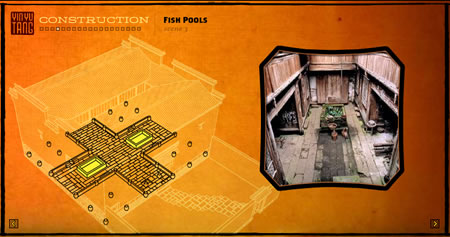
Japan
Visiting a Japanese House
This website has useful information but some of the spelling and grammar are poorly (hilariously) translated from Japanese.Creating Courses on the Environment from Asian Perspective: Visualizing Nature in Japan [Education About Asia]
This lesson plan will encourage students to begin thinking about culture through the lens of landscape. Download PDF on page.
Japanese Houses
Although Japan is significantly smaller than China, Japan's regional variations are important to recognize. Houses, as well as other aspects of Japanese material culture, are useful in understanding the regional character of Japanese culture.
Interactive Map of Japan's Regions, Prefectures, Districts, and Cities [Web Japan]
Japanese Houses [Kids Web Japan]
Discusses the history, structure, and furnishings of Japanese houses. With a game for visiting a virtual house.
Shirakawa Village: World Heritage Site
WEBSITES ABOUT THE ALPINE VILLAGE OF SHIRAKAWA AND ITS ARCHITECTURE:
The Historic Villages of Shirakawa-go and Gokayama [Japan National Tourist Organization]
Gassho-zukuri Village [Shirakawa.org]
Video of Shirakawa-go and Gokayama [UNESCO/NHK]
 Postage stamps featuring the Iwase Family House in Shirakawa-go.
Postage stamps featuring the Iwase Family House in Shirakawa-go.Korea
Traditional houses in Korea are best seen today in museum villages, where Korea's regional mosaic is most evident.
Websites about Traditional Korean Houses
Hanok, Traditional Korean House
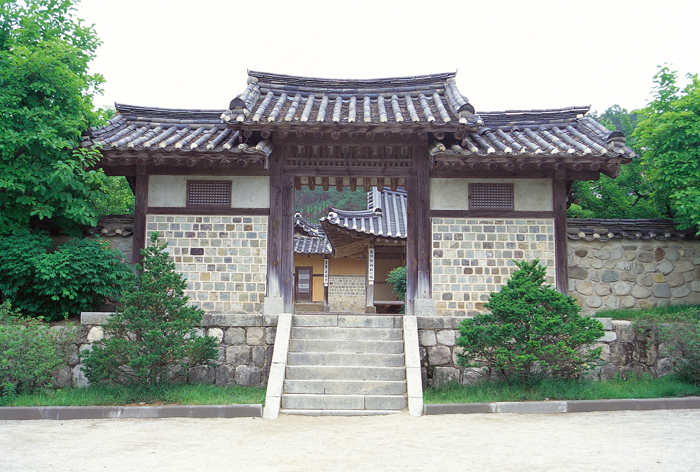
The Value and Meaning of the Korean Family [Asia Society]
Children incur a debt to their parents who gave birth to them and raised them. This debt lies behind the idea of filial duty: treating parents respectfully at all times, taking care of them in their old age, mourning them well at proper funerals, and performing ceremonies for them after their deaths. Even fulfilling these duties, however, is not enough to repay the debt to one's parents. The full repayment also entails having children and maintaining the continuity of the family line.
Vietnam
Architecture [Voyage to Vietnam]
The architecture in Vietnam is unique and beautiful. Homes, businesses, gateways and special buildings throughout the country vary by region and by purposeRural HousesTwo thatch-roofed houses elevated on wood columns, Mai Chau
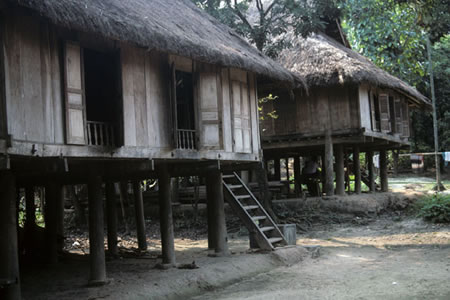
GEOMANCY / FENGSHUI
Fengshui: China's fengshui ('wind and water' or geomancy) and its variants in Japan, Korea, and Vietnam reveal clearly an awareness of sensitivity to recurring patterns of nature and a high level of environmental awareness. For an introduction to this subject in various contexts, visit:The Fengshui Gate: Essays on the Origin of Fengshui [Stephen L. Field, Trinity University]
The Art of Fengshui [TeacherVision]
A short article about fengshui. Useful as an introduction to the topic.
Patterns of Population: Urban and Rural Life over Time
Within East Asia, agriculturally-based settlements have existed in great variety, including nucleated settlements as well as dispersed villages.
Village settlements were the sites of residence for most of the population of East Asia, whie now, populations of all four countries have moved in greater numbers from the countryside into large towns and cities
Processes, Patterns, and Functions of Human Settlement
China and Japan, Urban Life 1000-1900
China: Urban Life During the Song Dynasty, C. 1100
The Song Dynasty in China (920-1279) [Asia for Educators]
Explore urban life in a 12th-century Chinese city during the period of the Song dynasty (960-1279). View images from the Beijing qingming scroll to learn about commercial, economic, intellectual, and social activities in a Song-dynasty urban center.Interactive Urban Mapper for 18th-century Suzhou [Asia for Educators]
Select one of the three shopping districts for an up-close look at one of China's great urban centers of the 17th and 18th centuries. Explore the rest of this website — Recording the Grandeur of the Qing — for more on the art, economy, and government of Qing-dynasty China.Ancient City of Ping Yao [UNESCO]
Take a virtual tour around this ancient Chinese city to see 21st-century street scenes and ancient buildings. This site offers an interesting group of virtual vistas to compare with Hedda Morrison's mid-20th-century black-and-white photographs of Pao-ting Fu (above). To get to the virtual tour, click on WHTour link at the very bottom of the page.Diaolou, Kaiping [Instituto Cultural do Governo da RAE de Macau]
Text and photographs about "dialou" (fortified watchtowers) of the Qing dynasty in Guandong province.Cities of the Song Dynasty (1000 CE) – China as the Most Advanced Society in the World
Woman traveling by sedan chair, Song dynasty

Store selling summer pillows made of white rattan, Qing dynasty
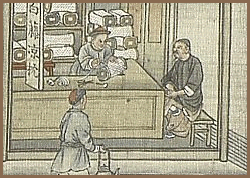
One Nation, Two Futures? [Wide Angle, PBS]
For grade 10. This lesson, using clips from the WIDE ANGLE film "To Have and Have Not" (2002) (available on the site, free of charge), can be used after a lesson on the Communist Revolution and Mao's rule. A basic knowledge of China's geography, of the tenets of Chinese Communism, and of Mao's efforts to redirect the course of China's future by means of the Cultural Revolution, is required for the successful completion of the lesson.
Japan: Edo (Tokyo) During the Tokugawa Period (1600-1868)
Travel Tokaido [PBS]
Travel the Tokaido road and see various modes of transport (palanquin, horseback, boat) and wayside stations (inns, shops), as well as rural, mountain, and urban scenery along this famously depicted route. Part of the website Japan: Memoirs of a Secret Empire.Welcome to Edo [NAJAS: National Association of Japan-America Societies]
Edo, the ancient name for Tokyo, was the center of power, economy, and social life during the reign of the Tokugawa shogunate, even though Japan's emperor reigned in the imperial capital in Kyoto. Using maps, photos, and drawings, this website leads students through this magnificent city in times past. Text and images from Edo-era Japan, including an illustrated text about Edo society and customs, a "Ukiyo-e" gallery of the artist Hokusai's "Fifty-three views of the Tokaido Road." This latter includes detail images of travelers passing dwellings and trades people occupied in their activities.Castle Towns [SPICE, Stanford University]
The SPICE curriculum unit Castle Towns: An Introduction to Tokugawa Japan introduces students to an early stage in the evolution of urban settlements in pre-modern and modern Japan.Japan Teaching Module: Geography Component 1: Japanese Cultural Landscapes [University of Tennessee at Chattanooga]
An excellent resource for teachers and students, with text, maps, and numerous photographs, organized into five sections: 1) General Characteristics of Japanese Cultural Landscapes Intro, Part 1, Part2; 2) Specific Characteristics of Japanese Cultural Landscapes; 3) Japan's Urban Cultural Landscapes; 4) Japan's Suburban Cultural Landscapes; 5) Japan's Rural Cultural Landscapes.Traveling by palanquin on the Tokaido road and The Gyotoku salt field, Edo
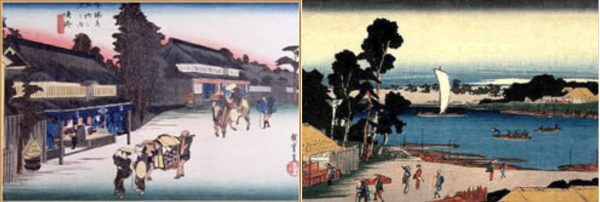
China and Japan Today, Urban and Rural
The Power of Place: Geography for the 21st Century [Video On Demand, Annenberg Media]
A series of 26 half-hour videos for high school classrooms. All videos are free and available online via Annenberg's "Video On Demand" service. Relevant to Asia are Program 9 (Changes on the Chang Jiang [Yangzi or Yangtze River]), Program 11 (A Challenge for Two Old Cities: Lanzhou and Shenyang), and Program 12 (Small Farms, Big Cities: Northern Japan, Tokyo).Global Urban Explosion [China Institute]
This lesson examines the environment impact of urban development around the world. By the conclusion of this lesson, students will be able to (1) describe the environmental problems, specifically air and water pollution, created by the rapid development of urban areas; (2) identify some solutions for dealing with problems caused by uncontrolled urbanization; and (3) explain the importance of urban development plans in dealing with cities’ environmental problems.A Tour of China’s Cities [Asia Society]
China is a country of immense variety in its terrain and geography, but the story of modern China is often told through its cities. According to Public Radio International, for the past two decades China has built twenty new cities each year. These urban centers draw people from China’s countryside and from around the world to take advantage of new economic opportunities. Click on any city on the map and start your trip around fifteen of China's most important cities.Shanghai: Metropolitan Idol [Asia Society]
A late bloomer, for centuries Shanghai was an outpost on China’s eastern seaboard. In 1750, it was a fishing village home to 50,000 people. Today, 10 million live in this city that has risen to superstardom, and is even known as the “head of the dragon.” It is China’s most populous city, leads the country’s commerce, is at the forefront of art and fashion, and hosts the busiest port in the world.Why did Shanghai rise to the top? Because it is perfectly located to take advantage of China’s ascent within the global community. Shanghai stands where the Yangzi River joins the Pacific Ocean, making it the gateway between China’s 1.3 billion people and the rest of the world.
The Rise of Eastern China: From Hoe Culture to Factory Culture [Education about Asia]
In the past twenty-five years, China has dramatically moved from a rural, agrarian economy and culture to become more urban and a major world economic and political force. In the process, key economic core areas have moved south and eastward, especially to the coast….Historically, China was a country of small-scale intensive farmers (a “hoe culture”), divided by the physical limits of climate, hydrology, topography, distances, and a population dominated by family and elders in which Confucianism was usually the dominant belief system. Later, the Communist Party defined one's future. These physical and social elements affected history, politics, dress, diet, architecture, demographics, and economics.
South Korea, Past and Present
 Myongdong, circa 1900 and present day
Myongdong, circa 1900 and present dayEconomic Interdependence in East ASIA
The Silver Trade in East Asia, 1400s-1800s: China-Japan-Latin America
China and Europe: 1500-1800, The Silver Trade [Asia for Educators]

Chinese Trade in the Indian Ocean in the Ming Dynasty [Asia Society]
A background essay on the Ming Dynasty, its powerful trade networks and diplomatic missions as far as Africa and the Red Sea, and the domestic tensions that ultimately changed the course of world history.
The Silk Road Past and Present
From Silk to Oil: Cross-cultural Connections along the Silk Roads [China Institute]
This downloadable curriculum guide provides a comprehensive view of the Silk Roads from the second century BCE to the contemporary period. The curriculum units underscore the patterns and networks of economic activity linking East Asia with the Mediterranean world through Central Asia. Included are five introductory essays, maps, and 23 curriculum units divided into the following five topics:
Ethnic Relations and Political History along the Silk Roads [PDF]
Art along the Silk Road [PDF]
The entire guide can be downloaded in PDF format, section by section. The geography section (Geography along the Silk Roads [PDF]) is especially strong.
Research on current state of China’s “Belt and Road” Initiative.
Have students search for current articles on the China’s “One Belt, One Road” Initiative across Eurasia and on the seas.- China's Massive Belt and Road Initiative [Council on Foreign Relations]
China's Belt and Road Initiative (BRI), sometimes referred to as the New Silk Road, is one of the most ambitious infrastructure projects ever conceived. Launched in 2013 by President Xi Jinping, the vast collection of development and investment initiatives would stretch from East Asia to Europe, significantly expanding China's economic and political influence.
Japan and Overseas Trade
Research Exercises: Japan's Economy and Trading Patterns [Asia for Educators]
First read the Japan's Economy and Trade Fact Sheet, then complete
Exercise 6 (Japan's Food Imports/American Food Exports),
Exercise 7 (Japan's Energy Imports in Comparison), and
Exercise 8 (Japan's Imports and Exports by Region).
Use this page for research on the exercise questions: Economy and Trade: Japan: Internet Resources.
Korea and Overseas Trade
Korea and the Silk Road: Gold Age, Golden Threads [Korea Society] (power point)
Koryo Korea's International Trade c. 1000: Imports and Exports (a skit) [Korea Society]
Intra-regional Trade within China in History
CHINA Historically was itself an Interdependent Market
Exploring the Grandeur of the Qing (1600s-1800s) - Economics [Asia for Educators]
“Unlike Europe during this same period, which was composed of many small states, each with its own political system, national boundary, and tax system, Qing China was a vast continental market with no impediments to the movement of goods across provincial boundaries (see map 'Comparing China and Europe' here-scroll to 2nd map). In analyzing the various institutions that were in place in China at this time, it is important to keep in mind that the structure of China’s large continental empire affected economic development, economic growth, and economic structures.”
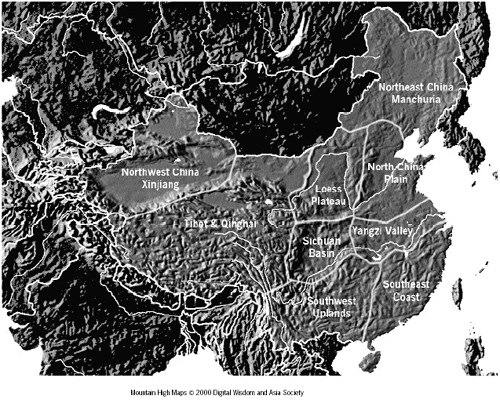

Competition and Cooperation for the Earth's Surface—in East Asia
Boundary disputes, tensions over larger territories, competition for scarce resources, and control of strategic
East Asia Foreign Relations
**Go to New York Times current events lesson plans for contemporary issues....such as the South China Sea disputes. NOTE: the articles are not in chronological order, so scroll down for latest or most relevantSouth China Sea Maritime Conflicts [Choices Program/Brown University]
Territorial Disputes in the South China Sea [Council on Foreign Relations]
China's Foreign Policy
China on the World Stage: Weighing the U.S. Response [Choices Program/Brown University]
U.S.- China Trade Tensions[Choices Program/Brown University]
In this lesson students examine primary sources from U.S. officials, scholars, journalists, and business leaders supporting and opposing Trump administration trade policies with China.The Umbrella Movement Protest in Hong Kong[Choices Program/Brown University]
Students analyze photographs of the protests in Hong Kong and explore the symbols and messages that protesters use to express their views.Taiwan and U.S.-China Relations [Asia for Educators]
A teaching unit with discussion questions and two primary source readings:
1) Excerpt from the U.S.-China Joint Communiqué, Issued at Shanghai, February 27, 1972;
2) Excerpts from the Taiwan Relations Act of 1979.Top Ten Things to Know about China in the World Today(video) [Asia for Educators]
China: Geography and Security Goals [Asia for Educators]
This unit explores how history and geography set the agenda for Chinese foreign policy. China's internal geography, regional geography, and the broader global context are discussed. Discussion questions are included.
Japan's Foreign Policy
Japan's Foreign Policy Today and the 70th Anniversary of the End of WWII (video) [Asia for Educators]
Japan's Foreign Policy and the Role in the World Today [Asia for Educators]
A short introduction to Japan's foreign policy, including summaries of Japan's relations with the U.S., Southeast Asia, Korea, Europe, the Persion Gulf nations, China, and Russia. With a short student activity.
The Korean Peninsula
The Top Ten Things to Know about KOREA in the 21st Century (video) [Asia for Educators]
Post-War Development of the Two Koreas [University of Tennessee, Chattanooga, Asia Program]
- Lesson Plans from the Korea Society [Korea Society]
GDP Economic Growth and Market Systems - Comparing the Economies of North and South Korea
Structured Academic Controversy - What is the Best Solution for North and South Korea Reunification
What Can Be Learned From A Set of Data - Comparing and Contrasting Life in the Two Koreas
The US in South Korea - Ally or Empire - Perspectives in Geopolitics
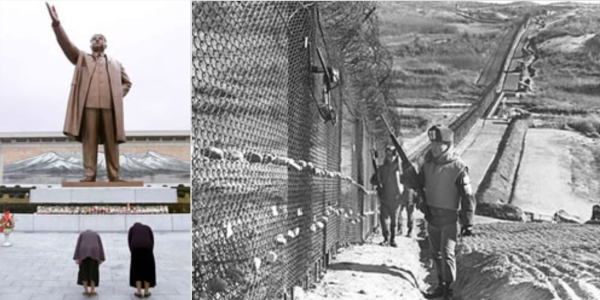 Two women bow to a 65-foot-high bronze statue of Kim II Sung, downtown Pyongyang (left); South Korean soldiers inspecting the fence along the south side of the DMZ, 1975 (right)
Two women bow to a 65-foot-high bronze statue of Kim II Sung, downtown Pyongyang (left); South Korean soldiers inspecting the fence along the south side of the DMZ, 1975 (right)Korea-Japan Foreign Relations
**Go to NYT learning Network search, note the articles are not in chronological order, so scroll down for latest or most relevant
Tensions between Japan and KoreaComfort Women - Teaching to the Truth [Korea Society]
Japanese Occupation in Korea [Korea Society]
Consequences of Japan's Occupation of Korea [Korea Society]
Becoming Japanese - Identity Under Japanese Occupation [Korea Society]
-
